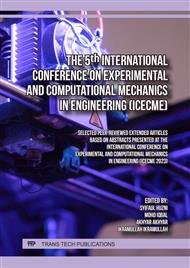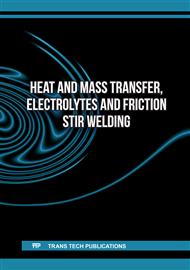[1]
M. Moghadami, "A narrative review of influenza: A seasonal and pandemic disease," Iran. J. Med. Sci., vol. 42, no. 1, p.2–13, 2017.
Google Scholar
[2]
M. Pai et al., "Tuberculosis," Nat. Rev. Dis. Prim., vol. 2, 2016.
DOI: 10.1038/nrdp.2016.76
Google Scholar
[3]
E. Schneider, "Severe Acute Respiratory Syndrome (SARS)," Netter's Infect. Dis., p.537–543, 2012.
DOI: 10.1016/B978-1-4377-0126-5.00089-6
Google Scholar
[4]
A. A. Gershon et al., "Varicella zoster virus infection," Nat. Rev. Dis. Prim., vol. 1, p.1–41, 2015.
DOI: 10.1038/nrdp.2015.16
Google Scholar
[5]
L. Borro, L. Mazzei, M. Raponi, P. Piscitelli, A. Miani, and A. Secinaro, "The role of air conditioning in the diffusion of Sars-CoV-2 in indoor environments: A first computational fluid dynamic model, based on investigations performed at the Vatican State Children's hospital," Environ. Res., vol. 193, Feb. 2021.
DOI: 10.1016/j.envres.2020.110343
Google Scholar
[6]
P. Bahl, C. Doolan, C. De Silva, A. A. Chughtai, L. Bourouiba, and C. R. Macintyre, "Airborne or Droplet Precautions for Health Workers Treating Coronavirus Disease 2019 ?," no. Xx Xxxx, p.1–8, 2020.
DOI: 10.1093/infdis/jiaa189
Google Scholar
[7]
P. E. Valenzuela, A. Ebadat, N. Everitt, and A. Parisio, "Closed-loop identification for model predictive control of HVAC systems: From input design to controller synthesis," IEEE Trans. Control Syst. Technol., vol. 28, no. 5, p.1681–1695, 2020.
DOI: 10.1109/TCST.2019.2917675
Google Scholar
[8]
A. Sporr, G. Zucker, and R. Hofmann, "Automated HVAC Control Creation Based on Building Information Modeling (BIM): Ventilation System," IEEE Access, vol. 7, p.74747–74758, 2019.
DOI: 10.1109/ACCESS.2019.2919262
Google Scholar
[9]
C. Anuntasethakul and D. Banjerdpongchai, "Design of Supervisory Model Predictive Control for Building HVAC System with Consideration of Peak-Load Shaving and Thermal Comfort," IEEE Access, vol. 9, p.41066–41081, 2021.
DOI: 10.1109/ACCESS.2021.3065083
Google Scholar
[10]
S. Jacob, S. S. Yadav, and B. S. Sikarwar, Design and simulation of isolation room for a hospital, no. August 2020. Springer Singapore, 2019.
DOI: 10.1007/978-981-13-6416-7_8
Google Scholar
[11]
European Centre for Disease Prevention and Controls, "Heating, Ventilation and Air-Conditioning Systems In The Context of COVID-19," Eur. Cent. Dis. Prev. Control., no. June, p.1–5, 2020, [Online]. Available: https://www.ecdc.europa.eu/sites/default/ files/documents/Ventilation-in-the-context-of-COVID-19.pdf
Google Scholar
[12]
K. Khankari, "Patient Room HVAC," ASHRAE J., vol. 58, no. 6, p.16–26, 2016.
Google Scholar
[13]
F. Wang, C. Chaerasari, D. Rakshit, I. Permana, and Kusnandar, "Performance improvement of a negative-pressurized isolation room for infection control," Healthc., vol. 9, no. 8, p.1–11, 2021.
DOI: 10.3390/healthcare9081081
Google Scholar
[14]
S. Bhattacharyya, K. Dey, A. R. Paul, and R. Biswas, "A novel CFD analysis to minimize the spread of COVID-19 virus in hospital isolation room," Chaos, Solitons and Fractals, vol. 139, p.110294, 2020.
DOI: 10.1016/j.chaos.2020.110294
Google Scholar
[15]
H. Hamdani et al., "HVAC Control Systems for a Negative Air Pressure Isolation Room and Its Performance," Sustainability, vol. 14, no. 18, p.11537, 2022.
DOI: 10.3390/su141811537
Google Scholar
[16]
D. Borda, M. Bergagio, M. Amerio, M. C. Masoero, R. Borchiellini, and D. Papurello, "Development of Anomaly Detectors for HVAC Systems Using Machine Learning," Processes, vol. 11, no. 2, p.1–26, 2023.
DOI: 10.3390/pr11020535
Google Scholar
[17]
G. Demirezen, A. S. Fung, and M. Deprez, "Development and optimization of artificial neural network algorithms for the prediction of building specific local temperature for HVAC control," Int. J. Energy Res., vol. 44, no. 11, p.8513–8531, 2020.
DOI: 10.1002/er.5537
Google Scholar
[18]
C. L. Weng and L. J. Kau, "Planning and design of a full-outer-air-intake natural air-conditioning system for medical negative pressure isolation wards," J. Healthc. Eng., vol. 2021, 2021.
DOI: 10.1155/2021/8872167
Google Scholar
[19]
S. Saran et al., "Heating, ventilation and air conditioning (HVAC) in intensive care unit," Crit. Care, vol. 24, no. 1, p.1–11, 2020.
DOI: 10.1186/s13054-020-02907-5
Google Scholar
[20]
W. Zheng et al., "COVID-19 Impact on Operation and Energy Consumption of Heating, Ventilation and Air-Conditioning (HVAC) Systems," Adv. Appl. Energy, vol. 3, no. May, p.100040, 2021.
DOI: 10.1016/j.adapen.2021.100040
Google Scholar
[21]
T. Thermometry and G. Usage, "Guide to Secondary Thermometry," p.1–62, 2021.
Google Scholar
[22]
E. Webster, "A critical review of the common thermocouple reference functions," Metrologia, vol. 58, no. 2, 2021.
DOI: 10.1088/1681-7575/abdd9a
Google Scholar
[23]
H. I. Inc., Non-Spring Return Direct-Coupled Damper Actuators for Contents of Package. 1985.
Google Scholar
[24]
G. Prytz, "A performance analysis of EtherCAT and PROFINET IRT," IEEE Int. Conf. Emerg. Technol. Fact. Autom. ETFA, no. 1396, p.408–415, 2008.
DOI: 10.1109/ETFA.2008.4638425
Google Scholar
[25]
G. Cena, I. C. Bertolotti, S. Scanzio, A. Valenzano, and C. Zunino, "Evaluation of EtherCAT distributed clock performance," IEEE Trans. Ind. Informatics, vol. 8, no. 1, p.20–29, 2012.
DOI: 10.1109/TII.2011.2172434
Google Scholar
[26]
M. Esrafilian-Najafabadi and F. Haghighat, "Impact of occupancy prediction models on building HVAC control system performance: Application of machine learning techniques," Energy Build., vol. 257, p.111808, 2022.
DOI: 10.1016/j.enbuild.2021.111808
Google Scholar
[27]
A. Al Mohammad, H. Hirmiz, G. Perera, and M. Maleki, "Motif-Based Occupancy Prediction for Energy Efficiency in HVAC," 2022 3rd Int. Conf. Pattern Recognit. Mach. Learn. PRML 2022, p.465–469, 2022.
DOI: 10.1109/PRML56267.2022.9882198
Google Scholar
[28]
S. Faddel, G. Tian, Q. Zhou, and H. Aburub, "On the Performance of Data-Driven Reinforcement Learning for Commercial HVAC Control," 2020 IEEE Ind. Appl. Soc. Annu. Meet. IAS 2020, 2020.
DOI: 10.1109/IAS44978.2020.9334865
Google Scholar
[29]
I. A. Rauf, "Basics of Machine Learning," Phys. Data Sci. Mach. Learn., no. May, p.125–155, 2021.
DOI: 10.1201/9781003206743-6
Google Scholar



